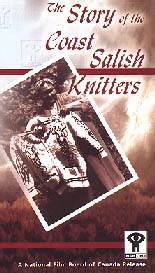|
________________
CM . . . .
Volume VII Number 7 . . . . December 1, 2000


|
The Story of the Coast Salish Knitters.
Christine Welsh (Director and Producer).
Montreal, PQ: National Film Board of Canada, 2000.
52 min., VHS, $39.95.
Order Number: C9100 028.
Subject Headings:
Knitting-Social aspects-British Columbia-History.
Coast Salish Indians-Social conditions.
Inidan handicraft industries-British Columbia.
Grade 6 and up / Ages 11 and up.
Review by Joan Payzant.
**** /4
|

The Story of the Coast Salish Knitters describes the origins of Cowichan sweaters, which have
travelled to far corners of the world and which have been worn by such notables as former
President Harry S. Truman and singer Bing Crosby.
Originally, the Coast Salish aboriginal people of southern Vancouver Island were weavers of
ceremonial blankets which utilized traditional native patterns. Since there were no sheep on the
island, little woolly white dogs provided the wool. The first white settlers brought sheep whose
wool was much sought after in its various natural colours - white, black, tans and greys. At a time
when it was difficult to earn a living, women started knitting sweaters which they sold to in
order to have money for food for their families. They worked extremely hard at their craft because
they started from "scratch," first washing the fleece by hand and then picking out twigs, straw and
other unwanted elements. Next came the difficult carding and hand spinning before the final
washing and their being able, at last, to start the actual knitting.
Not only the adult women knitted. Men, boys and girls learned the entire process just by watching
their elders. Often the young people made toques or socks to earn money for themselves. Patterns
were handed down through generations, patterns incorporating such elements as birds, animals of
the woodlands, stars, snowflakes, clams and waves. Knitters would sometimes work all night
when they were desperate for groceries. But, as so often happens, dealers exploited them. In
Victoria, the knitters were paid $55 for a sweater which they would later see on the dealer's rack
with a tag for $270. Since the wool, itself, cost $45, for all their labour the knitters only made
$10.
One brave woman tried to get a loan at a bank, but she had no success. She wanted to buy a
carding machine which could supply 33 pounds of carded wool per hour. Bank officials would not
listen to her request. So she simply sat in the bank until someone would talk to her. Although she
did not get a loan, she was allowed to buy the machine on her credit card. It was successful in that
the knitters could produce more sweaters at a greater rate, but the time they saved in carding was
used for more knitting with the result that they were working harder than ever.
Because of synthetic fabrics, there is not the demand for Cowichan sweaters today, but they are
still popular with aboriginals, selling well at gatherings like potlatches or canoe races. There is
happy footage of canoe races on the video, showing native built canoes each with several paddlers
in stiff competition. As an eastern Canadian, I was intrigued by the contrast to our local war
canoe races which take place between boat clubs. Here, the long canoes are factory produced, and
the paddlers are members of local boat clubs with few if any of Nova Scotia's aboriginal people
taking part.
The older women who were interviewed on this video had beautiful, wise faces, their serenity
mirroring their philosophy of life. For years, they have relied on their knitting when money was
scarce, and this work ethic, too, has been passed on to their children. However, today many
young people are opting for higher education, such as lawyer Lydia Hwitsum, daughter of one of
the knitters. With a little twinkle, Lydia acknowledges that, if she finds it difficult to make a living
in her profession, she, too, could fall back on knitting - which luckily is not apt to happen.
This is an excellent video, showing first of all how ingenuity solved the problem of feeding
families. Secondly, it illustrates the respect family members learn for each other as they work
together to make an industry successful.
Highly recommended.
Joan Payzant, a former teacher-librarian living in Dartmouth, NS, has always loved to knit.

To comment on this title or this review, send mail to cm@umanitoba.ca.
Copyright © the Manitoba Library Association.
Reproduction for personal use is permitted only if this copyright notice
is maintained. Any other reproduction is prohibited without
permission.
Published by
The Manitoba Library Association
ISSN 1201-9364
TABLE OF CONTENTS FOR THIS ISSUE - December 1, 2000.
AUTHORS |
TITLES |
MEDIA REVIEWS |
PROFILES |
BACK ISSUES |
SEARCH |
ORDER |
CMARCHIVE |
HOME
|
